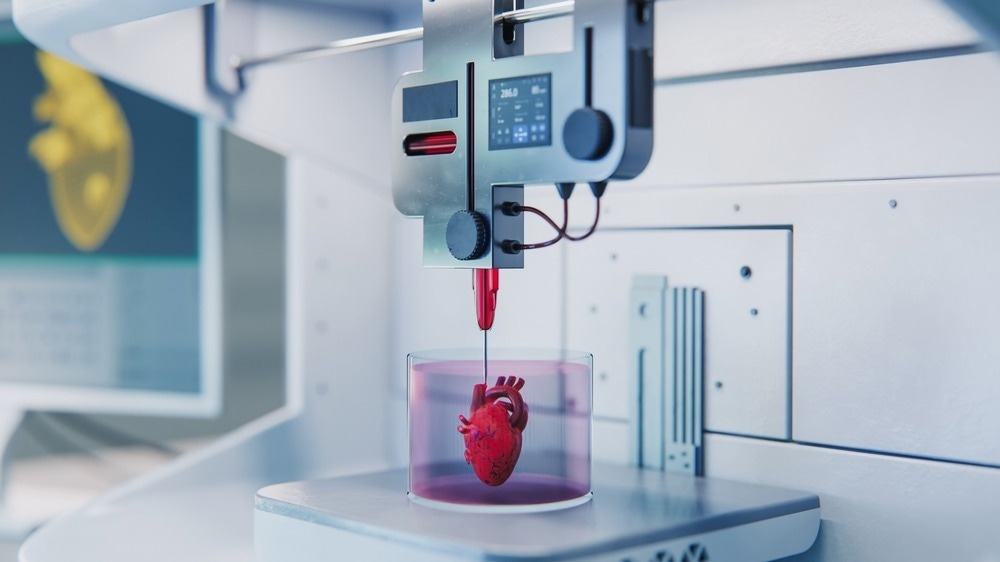3D bioprinting has significant potential in tissue engineering, the artificial development of tissues and organs for implantation, and the creation of tissue and organ models for pharmaceutical and toxicological research.1 This article explores recent innovations that have advanced the 3D bioprinting field.

Image Credit: Gorodenkoff/Shutterstock.com
What is 3D Bioprinting?
The rapid advancement of 3D bioprinting technology has revolutionized surgery, medicine, and dentistry. It allows for the creation of customized artificial implants and prosthetics tailored to individual patient preferences or specific surgical requirements.2
Tissue and organ damage is a major medical issue arising from aging, illness, trauma, and genetic conditions. Organ transplants from living or deceased donors have been the primary treatment, but there is a severe shortage of donor organs, exacerbated by the increasing number of recipients.
Organ transplants often face rejection by the recipient’s body. Researchers have turned to 3D bioprinting, which uses a patient’s genetic material to generate replacement organs. This personalized approach reduces the risk of rejection and eliminates the need for lifelong immunosuppressive medications.3
Moreover, bioprinting technologies support personalized medicine by manufacturing 3D organ cultures for various purposes. These cultures are crucial in drug development and toxicity testing, allowing researchers to observe tissue and disease formation and progression in controlled environments.4
Among the many advantages of 3D bioprinting, reproducing the complexities of body physiology in vitro is particularly promising. This capability opens new horizons for personalized medicine, enabling more customized implants and better drugs for individual patients.5
Current Market Trends in 3D Bioprinting
In the past five years, innovative 3D printing technology has led to the emergence of 3D bioprinting. The market size is estimated at 2 billion U. S. dollars.6 Recent technological innovations have significantly reduced the time required for bioprinting tissues and organs, leading to substantial revenue growth.
The research and commercial sectors have become significantly interested in 3D bioprinting, with substantial global investments. Market specialists expect a nearly 12 % increase in market value.
According to the “Technology Foresight Tool,” the number of 3D bioprinting patents has grown significantly from 2015 to 2023, totaling 2,868. Additionally, 24 new companies joined the patent race last year, bringing the total to 121 companies, indicating a growing focus and investment in advancing bioprinting technologies.
Key Innovations Shaping the Future of 3D Bioprinting
The University of Wisconsin–Madison has created the first 3D brain tissue that can grow and function like natural brain tissue. This discovery provides hope for treatments for neurological and neurodevelopmental disorders, including Alzheimer's and Parkinson's diseases.8
L'Oréal's Advanced Research team, in collaboration with the University of Oregon, has developed an artificial skin model closely matching human skin using 3D bioprinting.9 This innovation involved using melt electro-writing (MEW) to produce plastic scaffolds that mimic the extracellular matrix of natural skin.
3D bioprinting is also proving to be crucial in cancer research, playing a key role in combating dangerous diseases.
Challenges Limiting Wider Adoption
Selecting optimal biological materials that will not trigger immune rejection is crucial in 3D bioprinting. However, finding the right bioinks and scaffold materials remains challenging. Ensuring the survival and adjustment of embedded cells during the bioprinting process is essential, but this does not always happen, leading to damage and delays.
The created structures must remain stable and interact safely with surrounding tissues to avoid infection. Efforts are ongoing to ensure these structures are biocompatible, stable, and long-lasting.10 Public awareness and education are needed to address ethical concerns and confusion regarding bio-printed tissues.
The Future of 3D Bioprinting
The impact of 3D bioprinting technology on medicine and surgery is profound.
Recently, 4D printing has gained attention for its ability to create objects that reshape themselves, particularly shape-memory materials. These techniques offer applications in neural regeneration, drug screening, and disease modeling. They also hold promise for personalized diagnostics and precise therapeutic approaches for conditions like brain cancers.11
The potential of 3D to 6D printing offers exciting opportunities, marking a significant advancement in the field and fully unlocking the potential of bioprinting technology.
More from AZoM: Advancing AA2024 Aluminum Alloy: Microstructure to Mechanics Download PDF Copy
References and Further Reading
[1] Chameettachal, S., et al. (2019). 3D Bioprinting: Recent Trends and Challenges. J Indian Inst Sc.i. doi.org/10.1007/s41745-019-00113-z
[2] Javaid, M., et al. (2020). 3D printed tissue and organ using additive manufacturing: An overview. Clinical Epidemiology and Global Health. doi.org/10.1016/j.cegh.2019.12.008
[3] Shopova D., et al. (2023). (Bio)-printing in Personalized Medicine—Opportunities and Potential Benefits. Bioengineering. doi.org/10.3390/bioengineering10030287
[4] Mazzocchi, A., et al. (2019). 3D bioprinting for high-throughput screening: Drug screening, disease modeling, and precision medicine applications. App. Phys. doi.org/10.1063/1.5056188
[5] Lam, E., et al. (2023). 3D Bioprinting for Next-Generation Personalized Medicine. International Journal of Molecular Sciences. doi.org/10.3390/ijms24076357
[6] Grand View Research. (2024). 3D Bioprinting Market Size & Trends. [Online] Grand View Research. Available at: https://www.grandviewresearch.com/industry-analysis/3d-bioprinting-market (Accessed on May 06, 2024)
[7] ETHealthWorld. (2024). 3D Bioprinting Landmark Breakthroughs Signify Turning Point In Regenerative Medicine. [Online] ETHealthWorld. Available at: https://health.economictimes.indiatimes.com/news/industry/3d-bioprinting-landmark-breakthroughs-signify-turning-point-in-regenerative-medicine/107918334?utm_source=top_news&utm_medium=tagListing (Accessed on May 08, 2024)
[8] Universities of Wisconsin. (2024). UW–Madison researchers first to 3D-print functional human brain tissue. [Online] Universities of Wisconsin. Available at: https://www.wisconsin.edu/all-in-wisconsin/story/uw-madison-researchers-first-to-3d-print-functional-human-brain-tissue/ (Accessed on May 08, 2024)
[9] L'Oréal. (2024). Revolutionizing Tissue Engineering. [Online] L'Oréal. Available at: https://www.loreal.com/en/news/research-innovation/revolutionizing-tissue-engineering/
(Accessed on May 09, 2024)
[10] Yuan, X, et al. (2024). Recent developments and challenges of 3D bioprinting technologies. International Journal of Bioprinting. doi.org/10.36922/ijb.1752
[11] Amiri, E., et al. (2023). Recent advances and future directions of 3D to 6D printing in brain cancer treatment and neural tissue engineering. Biomedical Materials. doi.org/10.1088/1748-605X/ace9a4
Disclaimer: The views expressed here are those of the author expressed in their private capacity and do not necessarily represent the views of AZoM.com Limited T/A AZoNetwork the owner and operator of this website. This disclaimer forms part of the Terms and conditions of use of this website.